Mechanical Performance of rPET Filament Obtained by Thermal Drawing for FFF Additive Manufacturing
Abstract
:1. Introduction
1.1. From Production to Plastic Pollution
1.2. rPET Filament for 3D Printing
2. Materials and Methods
2.1. rPET Filament Production
2.2. 3D Printing of Test Specimens
- Bed temperature: 70 °C;
- Fan speed: 30%;
- Print speed: 30 mm/s.
- represents the section area of the commercial filament;
- denotes the section radius of the commercial filament.
2.3. Tensile Tests
3. Results
3.1. Comparison Between rPET and PETG
3.2. Comparison of rPET Obtained from Different Brands of Water Bottles
3.3. Comparison Between the Strips Obtained from the Bottle and the Specimens Obtained from These Strips After Transforming Them into a Filament and Using Them in FFF Additive Manufacturing
4. Discussion
4.1. Comparison Between rPET and PETG
4.2. Comparison of rPET Obtained from Different Brands of Water Bottles
4.3. Comparison Between the Strips Obtained from the Bottle and the Specimens Obtained from These Strips After Transforming Them into Filaments and Using Them in 3D Printing
5. Conclusions
- Material inconsistencies: During the plastic strip cutting process, minor variations in the strip width can lead to larger hollow cores in the filament, affecting the printing quality.
- Temperature fluctuations in drawing: Small temperature variations during drawing can alter the filament’s quality and consistency, impacting the final properties of rPET.
Author Contributions
Funding
Data Availability Statement
Acknowledgments
Conflicts of Interest
References
- Ritchie, H.; Samborska, V.; Roser, M. Plastic Pollution. Our World in Data. 2023. Available online: https://ourworldindata.org/plastic-pollution (accessed on 12 January 2025).
- Plastics. European Commission. 2023. Available online: https://environment.ec.europa.eu/topics/plastics_en (accessed on 12 January 2025).
- Plastics Europe. European Plastics Manufacturers Quarterly Report; Plastics Europe: Brussels, Belgium, 2023; pp. 1–8. Available online: https://plasticseurope.org/knowledge-hub/quarterly-report-q1-2023/ (accessed on 12 January 2025).
- Woolven, J. This Article is Not About Plastic Pollution. Ellen MacArthur Foundation. 2021. Available online: https://www.ellenmacarthurfoundation.org/pt/artigos/este-nao-e-um-artigo-sobre-poluicao-por-plasticos (accessed on 12 January 2025).
- Morales-Caselles, C.; Viejo, J.; Martí, E.; González-Fernández, D.; Pragnell-Raasch, H.; González-Gordillo, J.I.; Montero, E.; Arroyo, G.M.; Hanke, G.; Salvo, V.S.; et al. An inshore–offshore sorting system revealed from global classification of ocean litter. Nat. Sustain. 2021, 4, 484–493. [Google Scholar] [CrossRef]
- Ocean Care. Plastic: Harmful Throughout Its Entire Life Cycle. 2022. Available online: https://www.oceancare.org/en/stories_and_news/plastic-harmful-throughout-its-entire-life-cycle/ (accessed on 12 January 2025).
- Laville, S.; Taylor, M. A Million Bottles a Minute: World’s Plastic Binge “as Dangerous as Climate Chang”. The Guardian. 2017. Available online: https://www.theguardian.com/environment/2017/jun/28/a-million-a-minute-worlds-plastic-bottle-binge-as-dangerous-as-climate-change (accessed on 12 January 2025).
- Rashwan, O.; Koroneos, Z.; Townsend, T.G.; Caputo, M.P.; Bylone, R.J.; Wodrig, B.; Cantor, K. Extrusion and characterization of recycled polyethylene terephthalate (rPET) filaments compounded with chain extender and impact modifiers for material-extrusion additive manufacturing. Sci. Rep. 2023, 13, 16041. [Google Scholar] [CrossRef] [PubMed]
- Shen, L.; Pu, X.; Sun, Y.; Chen, J. A study on thermoelectric technology application in net zero energy buildings. Energy 2016, 113, 9–24. [Google Scholar] [CrossRef]
- Sadhukhan, J. Net zero electricity systems in global economies by life cycle assessment (LCA) considering ecosystem, health, monetization, and soil CO2 sequestration impacts. Renew. Energy 2022, 184, 960–974. [Google Scholar] [CrossRef]
- Jones, M. PETG/PLA Recycling: How to Recycle 3D Printer Waste. All3DP. 2023. Available online: https://all3dp.com/2/3d-printer-recycled-plastic-tips-for-your-waste-plastic/ (accessed on 12 January 2025).
- Boyd, G.; Burr, E. 3D Printers & Recycled Plastic: Can They Print Recycled Plastic? All3DP. 2023. Available online: https://all3dp.com/2/3d-printers-recycled-plastic/ (accessed on 12 January 2025).
- Méndez, G.M.; Del Cerro Pérez, A.; Del Cerro Velázquez, F. Prototype Pultrusion of Recycled Polyethylene Terephthalate Plastic Bottles into Filament for 3D Eco-Printing: Education for a Sustainable Development Project. Sustainability 2024, 16, 8347. [Google Scholar] [CrossRef]
- Yauri, R.; Bermeo, H.; León, A.; Llerena, O. Processing System for Plastic Bottle to Obtain Polyethylene Terephthalate Filament in 3D Printers. WSEAS Trans. Syst. Control. 2024, 19, 1–9. [Google Scholar] [CrossRef]
- Tylman, I.; Dzierżek, K. Filament for a 3D Printer from Pet Bottles- Simple Machine. Int. J. Mech. Eng. Robot. Res. 2020, 9, 1386–1392. [Google Scholar] [CrossRef]
- Bearing PET Bottle Cutter Using 8 × 22 × 7 mm Roller Skate Bearings. By Jattie|Download Free STL Model|Printables.com. Available online: https://www.printables.com/model/685409-bearing-pet-bottle-cutter-using-8x22x7mm-roller-sk (accessed on 12 January 2025).
- Compact PET Filament Machine by Mirabatek|Download Free STL Model|Printables.com. Available online: https://www.printables.com/model/460950-compact-pet-filament-machine (accessed on 12 January 2025).
- Kong, Y.; Hay, J. Multiple melting behaviour of poly(ethylene terephthalate). Polymer 2003, 44, 623–633. [Google Scholar] [CrossRef]
- Forward. Ultrafuse® rPET. 2024. Available online: https://forward-am.com/material-portfolio/ultrafuse-filaments-for-fused-filaments-fabrication-fff/standard-filaments/ultrafuse-rpet/ (accessed on 12 January 2025).
- Woern, A.L.; McCaslin, J.R.; Pringle, A.M.; Pearce, J.M. RepRapable Recyclebot: Open source 3-D printable extruder for converting plastic to 3-D printing filament. HardwareX 2018, 4, e00026. [Google Scholar] [CrossRef]
- Form Futura. ReForm—rPET. 2024. Available online: https://formfutura.com/product/reform-rpet/ (accessed on 12 January 2025).
- ISO 527-2; Plastics—Determination of Tensile Properties—Part 2: Test Conditions for Moulding and Extrusion Plastics. International Organization for Standardization: Geneva, Switzerland, 2012.
- ASTM D638; Standard Test Method for Tensile Properties of Plastics. ASTM International: West Conshohocken, PA, USA, 2020.
- Lang, L.; Antunes, R.; Dutra, T.A.; Aguiar, M.L.; Pereira, N.; Gaspar, P.D. Gaspar Mechanical Characterization and Performance Analysis of TPU 60A for Soft Robotic Grippers: Experimental Testing and Computational Simulation. Materials 2025, 18, 240. [Google Scholar] [CrossRef]

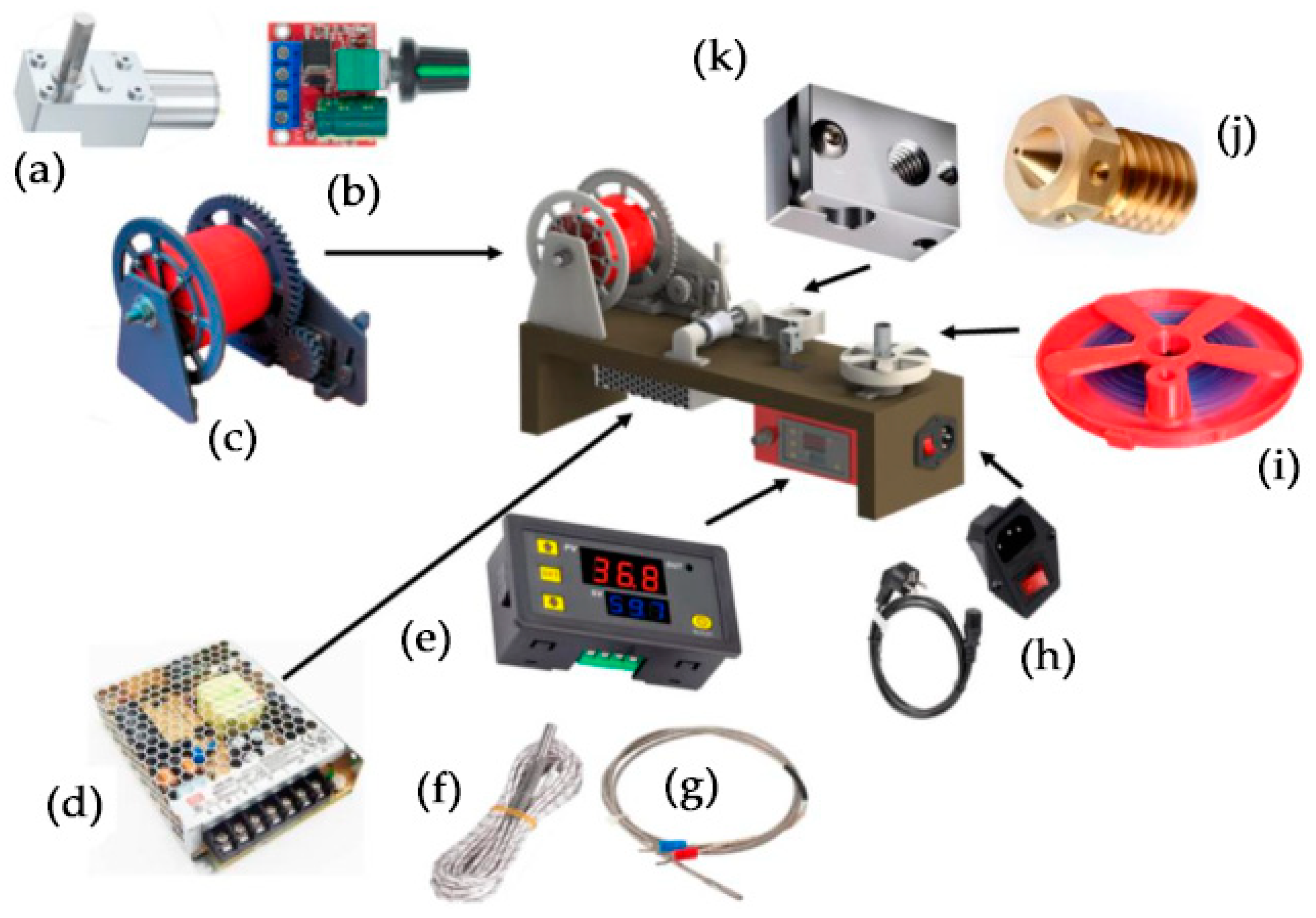
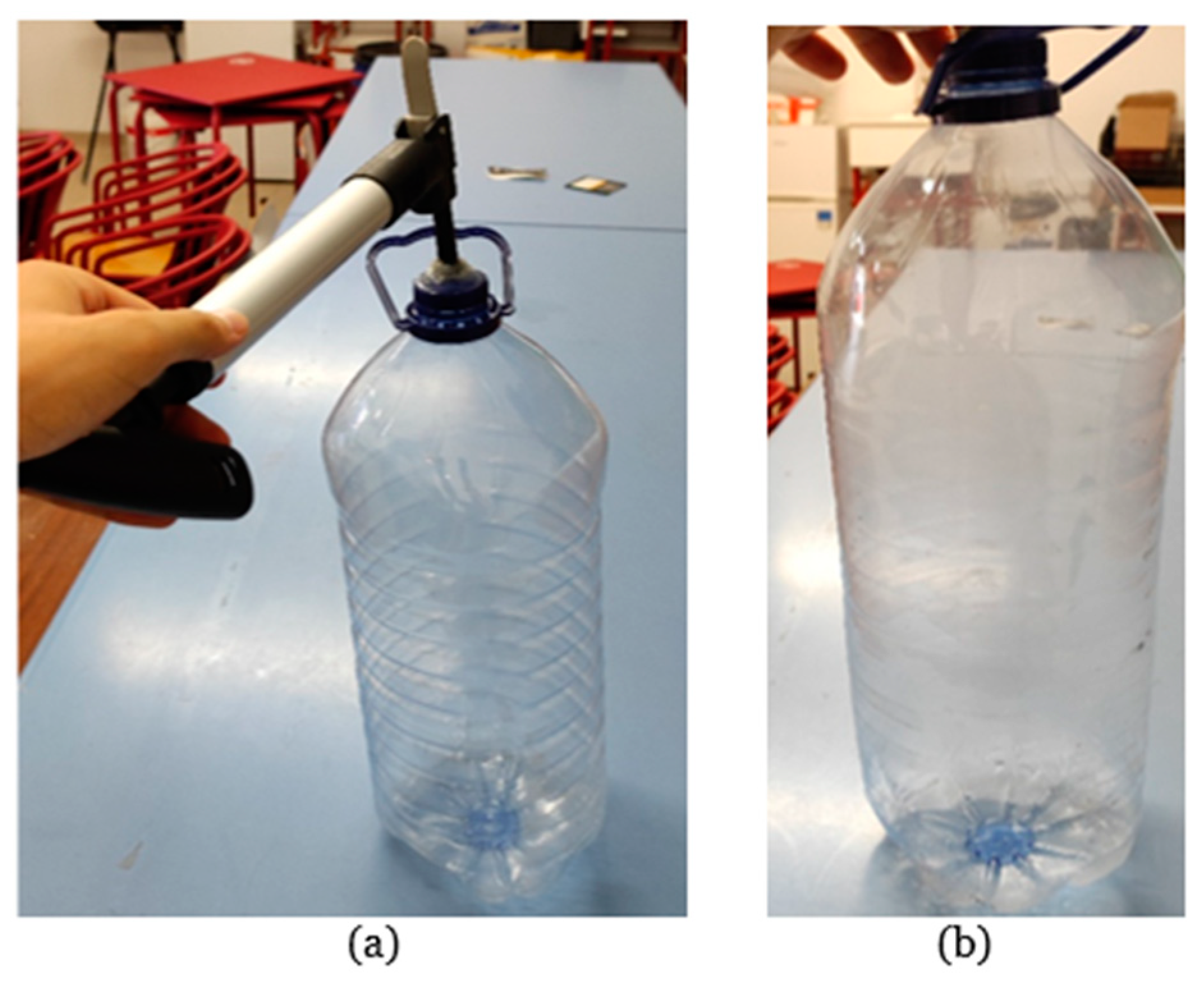
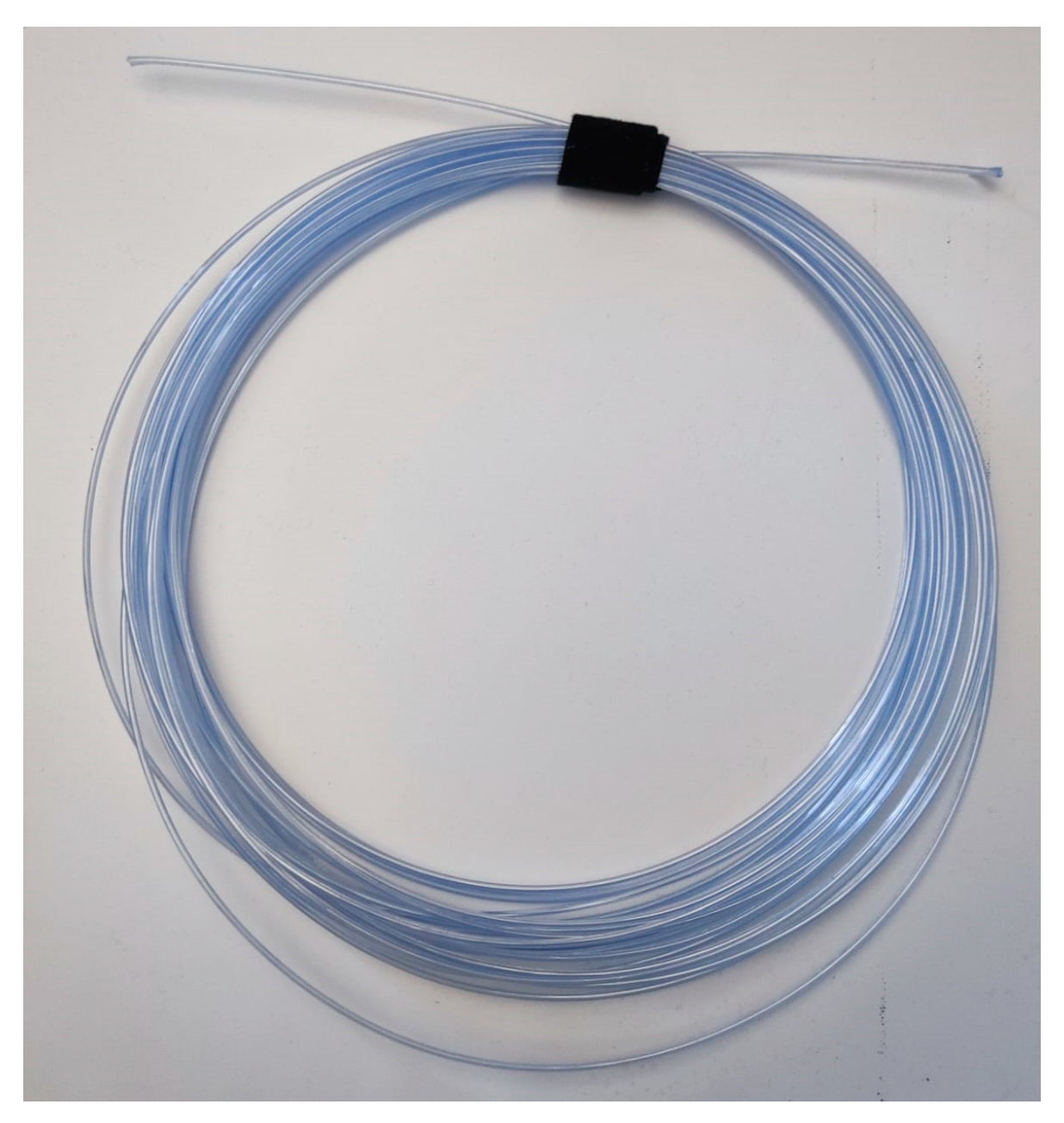
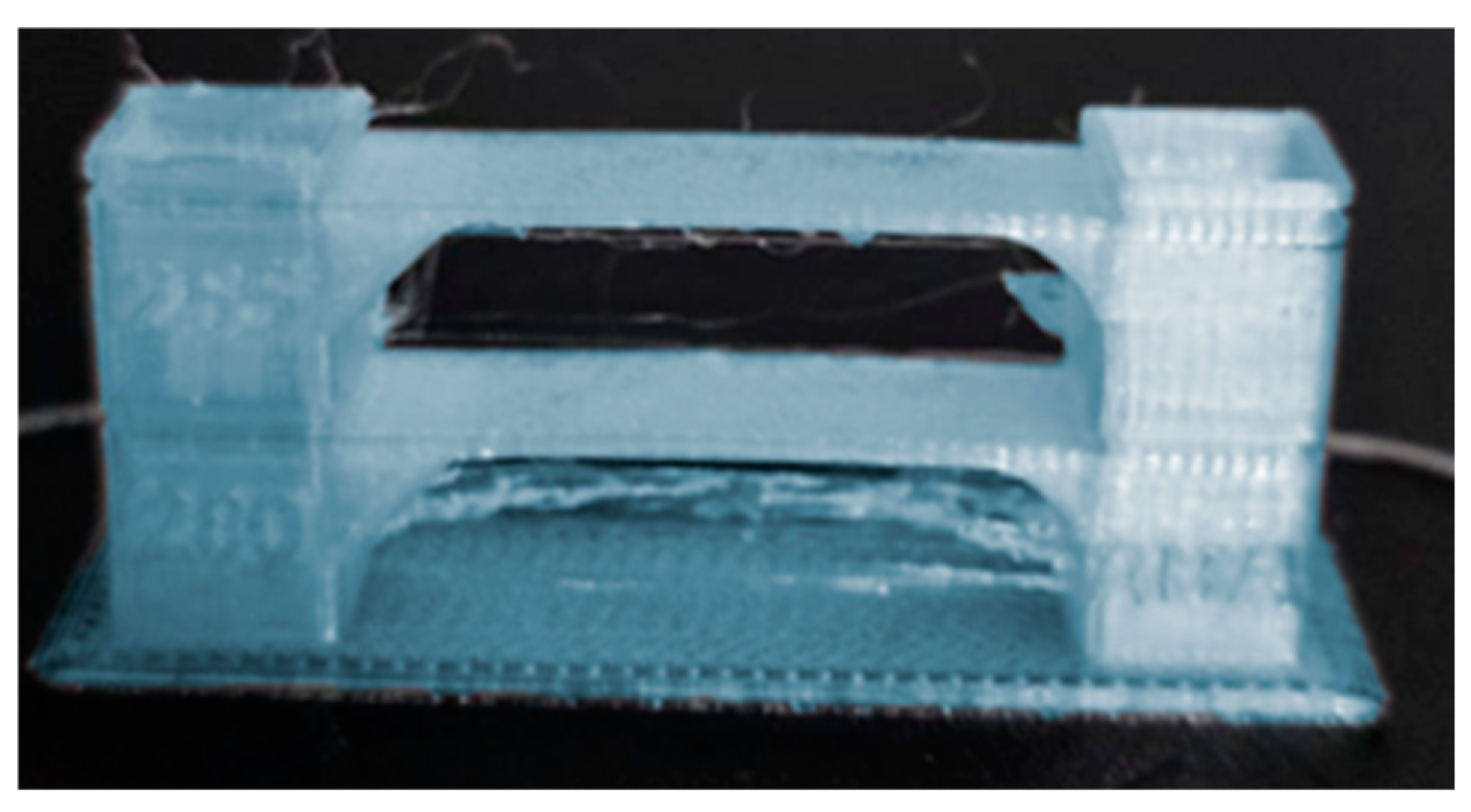
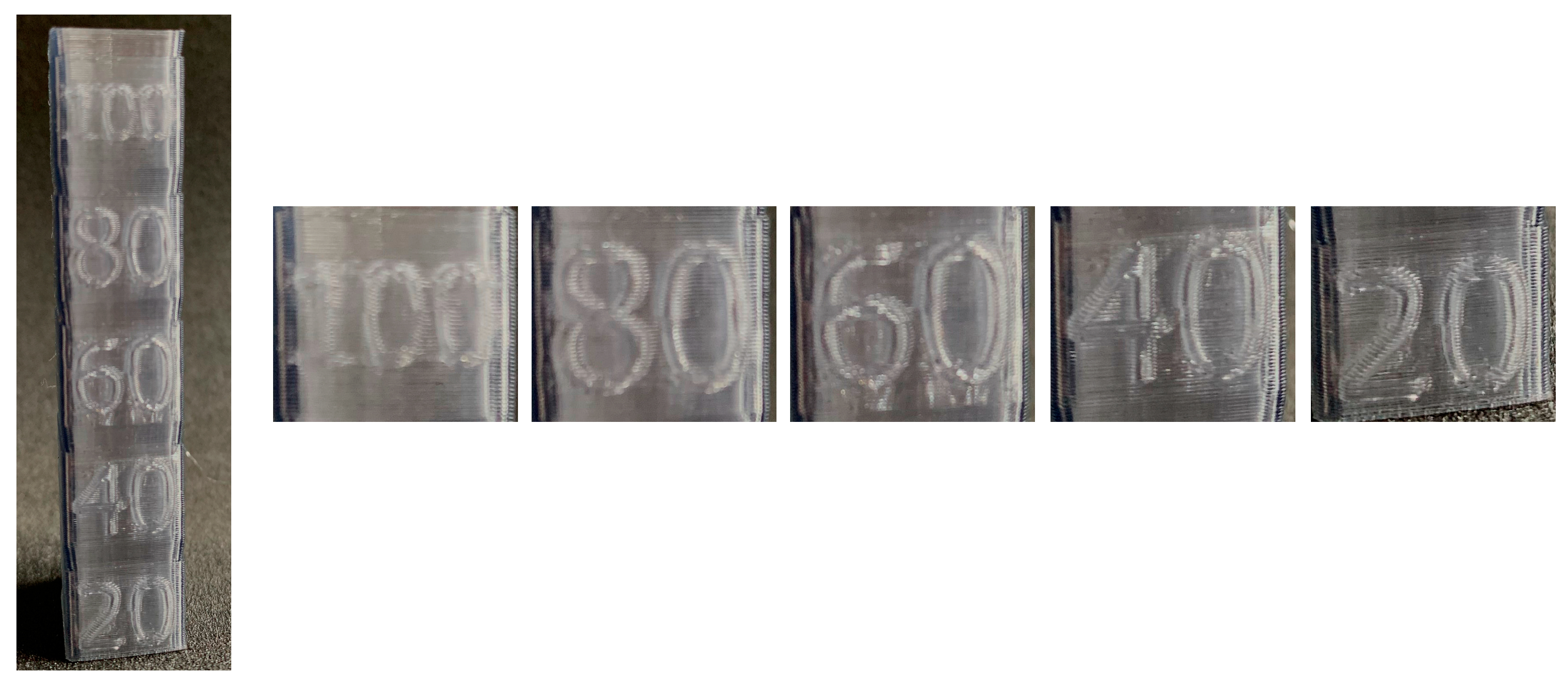






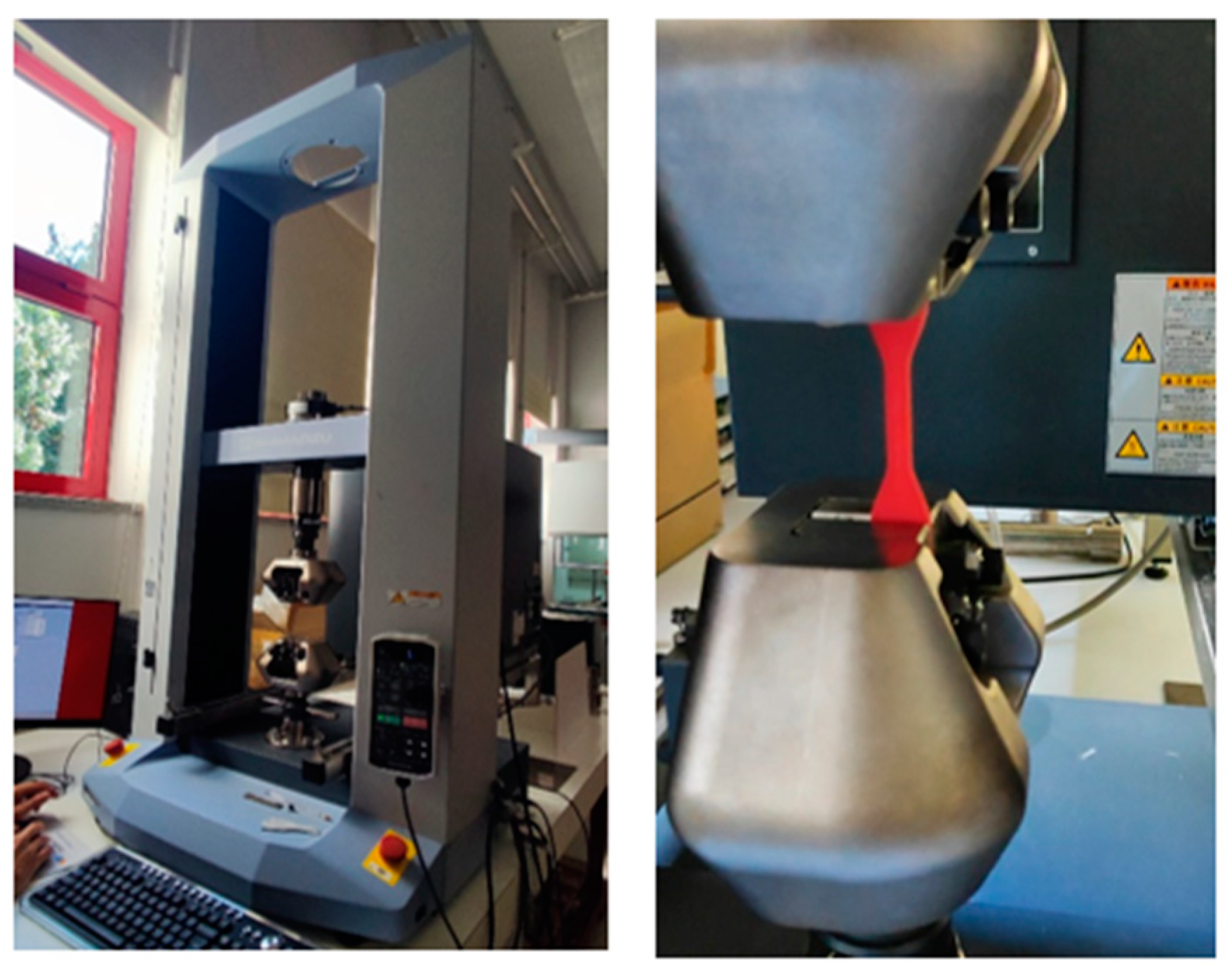
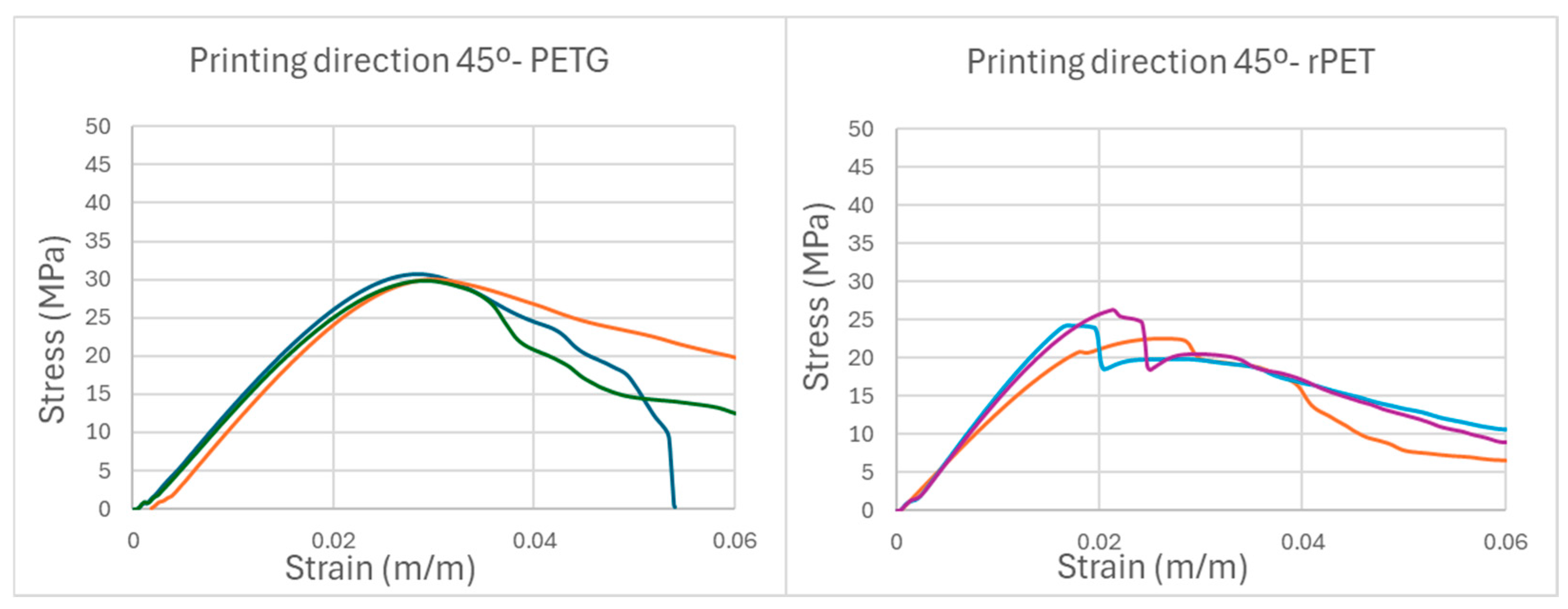
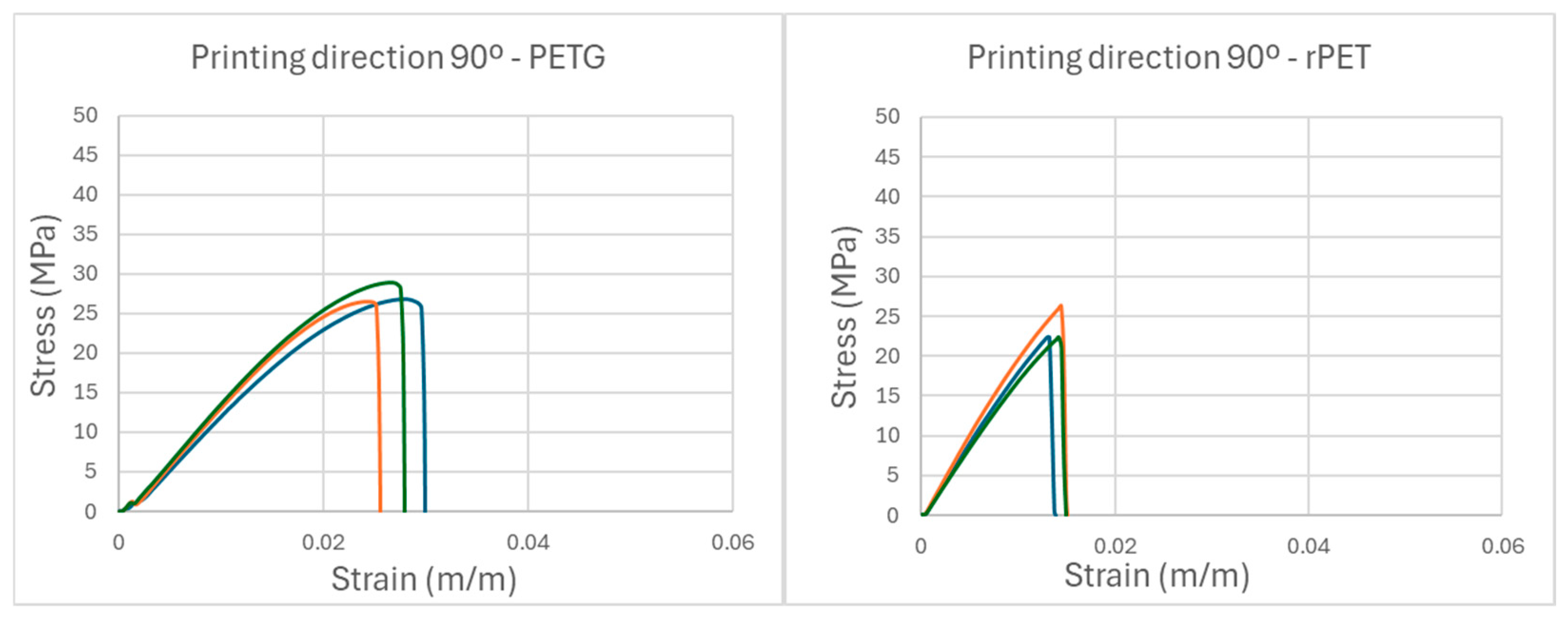


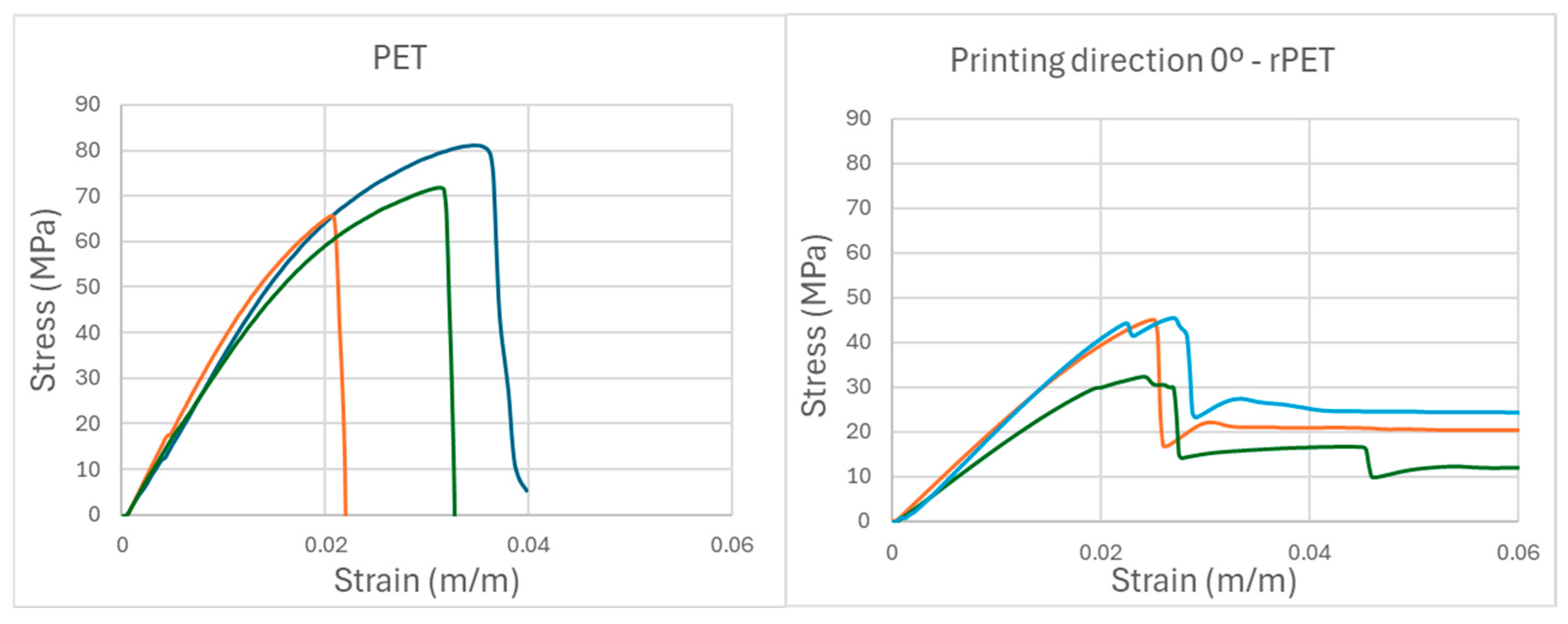
| Strip Width (mm) | Filament Diameter (mm) | Observations |
|---|---|---|
| 6.5 | n/a | The filament is not completely closed. |
| 7 | 1.65 | In certain parts of the filament, there are parts that do not close well. |
| 7.5 | 1.72 | The filament is closed. |
| 8 | 1.74 | |
| 8.5 | 1.75 | |
| 9 | 1.75 | |
| 9.5 | 1.76 | |
| 10 | 1.76 | |
| 10.5 | 1.77 | |
| 11 | 1.78 | |
| 11.5 | 1.8 | The motor starts to exert a lot of effort and sometimes slows down. |
| 12 | n/a | The filament breaks. |
| Tensile Strength (MPa) | Young’s Modulus (GPa) | Deformation at Failure (mm/mm) | Failure Mode | Image of the Rupture | |
|---|---|---|---|---|---|
| rPET 45° | 24.23 ± 1.85 | 1.43 ± 0.29 | 0.02 ± 0.01 | Partially ductile fracture |  |
| PETG 45° | 29.97 ± 0.48 | 1.44 ± 0.03 | 0.03 ± 001 | Partially ductile fracture |  |
| Tensile Strength (MPa) | Young’s Modulus (GPa) | Deformation at Failure (mm/mm) | Failure Mode | Image of the Rupture | |
|---|---|---|---|---|---|
| rPET 90° | 22.38 ± 2.26 | 1.87 ± 0.16 | 0.01 ± 0.0001 | Fragile fracture |  |
| PETG 90° | 26.88 ± 1.33 | 1.38 ± 0.08 | 0.03 ± 0.001 | Fragile fracture |  |
| Tensile Strength (MPa) | Young’s Modulus (GPa) | Deformation at Failure (mm/mm) | Failure Mode | Image of the Rupture | |
|---|---|---|---|---|---|
| rPET 0° | 45.20 ± 7.52 | 2.19 ± 0.01 | 0.02 ± 0.34 | Ductile fracture |  |
| PETG 0° | 48.68 ± 0.87 | 1.91 ± 0.01 | 0.03 ± 0.001 | Ductile fracture |  |
| Tensile Strength (MPa) | Young’s Modulus (GPa) | Deformation at Failure (mm/mm) | Failure Mode | Image of the Rupture | |
|---|---|---|---|---|---|
| rPET Luso 45° | 24.23 ± 1.85 | 1.43 ± 0.29 | 0.02 ± 0.01 | Partially ductile fracture |  |
| rPET Penacova 45° | 27.38 ± 3.91 | 2.78 ± 0.1 | 0.01 ± 0.001 | Partially brittle fracture |  |
| Tensile Strength (MPa) | Young’s Modulus (GPa) | Deformation at Failure (mm/mm) | Failure Mode | Image of the Rupture | |
|---|---|---|---|---|---|
| rPET 0° | 45.20 ± 7.52 | 2.19 ± 0.01 | 0.02 ± 0.34 | Ductile fracture |  |
| PET Luso | 71.86 ± 7.81 | 3.64 ± 0.34 | 0.03 ± 0.01 | Fragile fracture |  |
Disclaimer/Publisher’s Note: The statements, opinions and data contained in all publications are solely those of the individual author(s) and contributor(s) and not of MDPI and/or the editor(s). MDPI and/or the editor(s) disclaim responsibility for any injury to people or property resulting from any ideas, methods, instructions or products referred to in the content. |
© 2025 by the authors. Licensee MDPI, Basel, Switzerland. This article is an open access article distributed under the terms and conditions of the Creative Commons Attribution (CC BY) license (https://creativecommons.org/licenses/by/4.0/).
Share and Cite
Pires, P.; Aguiar, M.L.d.; Vieira, A.C. Mechanical Performance of rPET Filament Obtained by Thermal Drawing for FFF Additive Manufacturing. J. Manuf. Mater. Process. 2025, 9, 26. https://doi.org/10.3390/jmmp9010026
Pires P, Aguiar MLd, Vieira AC. Mechanical Performance of rPET Filament Obtained by Thermal Drawing for FFF Additive Manufacturing. Journal of Manufacturing and Materials Processing. 2025; 9(1):26. https://doi.org/10.3390/jmmp9010026
Chicago/Turabian StylePires, Pedro, Martim Lima de Aguiar, and André Costa Vieira. 2025. "Mechanical Performance of rPET Filament Obtained by Thermal Drawing for FFF Additive Manufacturing" Journal of Manufacturing and Materials Processing 9, no. 1: 26. https://doi.org/10.3390/jmmp9010026
APA StylePires, P., Aguiar, M. L. d., & Vieira, A. C. (2025). Mechanical Performance of rPET Filament Obtained by Thermal Drawing for FFF Additive Manufacturing. Journal of Manufacturing and Materials Processing, 9(1), 26. https://doi.org/10.3390/jmmp9010026






